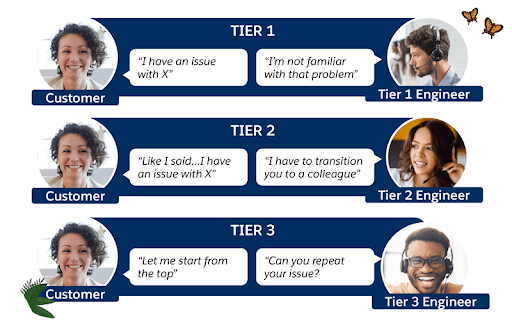How Our Support Agents Use Case Swarming With Slack To Solve Cases Fast



The traditional customer service model can be ineffective and frustrating. Here’s what happened when our agents tried case swarming for complex cases.
The pressure on customer service teams continues to increase. Customers expect instant help — either by solving problems themselves with self-service resources or by talking directly to a support agent. They’re looking for support that’s both easy and expert.
But the traditional support model of transferring difficult tasks up the chain doesn’t cut it anymore. In fact, 82% of customers expect to solve complex problems by talking to one person, according to Salesforce’s State of the Connected Customer report.
The old way of providing support for complex cases means multiple agent handoffs and longer resolution times. That’s frustrating for the customer. They have to repeat information about their issue to several case owners, and rightly feel their time is not valued.
It’s also a big problem for your service agents. Multiple handoffs force agents to spend more time on cases they aren’t qualified to solve, which takes time away from their primary area of expertise. Additionally, transferring cases limits their visibility and ability to learn from teammates.
The solution to this outdated model is case swarming with Slack. Swarming — also known as Intelligent Swarming — is a tactic that brings the entire support team together in Slack to help solve customers’ complex problems.
With swarming, the case owner remains the primary agent for the case life cycle. The key difference is they can now easily access and collaborate with the appropriate experts within the company.

At Salesforce and Slack, we gave our own agents the tools and structures they needed to work efficiently and focus on making customers happy. We first redefined our strategy and restructured our support teams into groups, or swarm pods, based around particular skill sets.
We continued to rout customers to specific case owners, to ensure just one agent served them throughout the process. Yet we gave these agents the ability to reach out when they needed help on complex cases. They could initiate a swarm request in Service Cloud or Slack and bring in cross-functional experts based on their skills, capacity, and availability.
When the request comes in, a pod of experts reviews the issue and provides solutions to the case owner. Other people who need to stay informed, such as an account executive or technical account manager, can be added to the swarm. Creating swarm pods puts the customer at the center of the support experience, giving them quicker access to a wider range of expertise from a team of support engineers.
How to collaborate with Slack
Each of our swarm pods supports a different Salesforce product, although some pods offer a specific skill set or specialty. Support engineers collaborate within their pods, and can also jump into other pods to help. There’s no need to escalate a complex issue — a case owner can quickly connect with the right person or people to resolve the issue.
We use Slack as our collaboration tool because it allows cross-functional teams to communicate. It also showcases key case details directly in the swarm conversations, supporting decision making from anywhere. It even allows direct access to the case when users need to see the full case history. This helps teams create a Digital HQ for Service — Service Cloud and Slack together — for a streamlined agent experience and personalized customer engagement in one place.

Slack gives our support pods the flexibility to work together to resolve even major issues quickly through the use of our Expert Finder tool in Service Cloud. The Expert Finder is embedded in the Slack swarming workflow and helps connect service teams automatically to the right swarm experts based on skills, availability, and capacity.
Here’s how it works: if an engineer needs help on a case, they initiate a swarm request in Service Cloud and select the Expert Finder tool when prompted. The swarm is created, and the workflow automatically brings in the appropriate engineers, other pods, and any cross-functional subject matter experts or managers through Slack channels to swarm the case.
With the power of Slack, agents have additional tools such as workflows and bots to help them resolve cases. Workflows allow agents to streamline the case process and take actions such as updating the case, notifying the customer, and even closing the case, all while in Slack. With workflows, Slack channels become interactive with buttons and links to Service Cloud. Slack Bots expand automation processes even further, such posting reminders or notification when updates arrive in the Slack channel.
This approach allows our engineers to resolve customers’ problems faster, while also shielding customers from the complexity and multiple hand-offs of a traditional support model. A unified Digital HQ for Service allows our teams to drive efficiencies and become more effective at scale. Incorporating automation into workflows and processes also frees up our teams to focus on other important tasks, including strengthening customer relationships.
As a result, Salesforce has seen a 26% reduction in case resolution time since introducing a tierless support model using case swarming with Slack, despite an increase in customers and case volume over the same period.
Case swarming with Slack helps you coach and mentor in real time
With the case swarming process, our engineers are regularly collaborating with engineers in other pods. They are also working with highly skilled experts in their area of expertise. They’re constantly learning from each other, accelerating their skills, and broadening their knowledge.
Meanwhile, “pod leads” can coach and mentor their teams in a real-time, collaborative way, instead of the traditional, review-style management approach.
As a result, the company gains a more effective support team, while engineers gain additional skills and knowledge for their own professional development. When teams succeed, their service quality and employee retention often increase as well.
Extend swarming to new teams
Ultimately, swarming has improved collaboration between our support teams, managers, and customers. The success of swarming for our service teams has led us to test how it could benefit other teams across Salesforce.
When product teams leverage a centralized Digital HQ for Service, their access to real-time feedback improves efficiency and creates better customer experiences. Teams can monitor issues as they unfold, identify ongoing challenges, and come up with new ways to improve products for customers.
Even in a highly collaborative service department, swarming improves customer service by allowing teams to share knowledge, experiences, and resources in real time. When service providers have the right knowledge, experts, and tools to solve cases, they gain the confidence they need to “lean in” for true personal connections that build loyalty for life.
Transform customer experiences with case swarming in Slack
Give customers an all-digital, human-centered experience with Salesforce and Slack.


















![[Illustration] An AI agent provides B2B customer service](https://www.salesforce.com/blog/wp-content/uploads/sites/2/2024/12/B2B-AI-Agents-1680x1120-1.jpg?w=128&h=96&crop=1&quality=75)



![A woman holds a phone while smiling at two nearby options, a chat screen and an AI bot. [Image: wayhome.studio / Adobe Stock]](https://www.salesforce.com/blog/wp-content/uploads/sites/2/2024/11/chatbot-AI-customer-service-agent-1500x844-1.jpg?w=128&h=96&crop=1&quality=75)
![[Illustration] A service rep delivers proactive customer service](https://www.salesforce.com/blog/wp-content/uploads/sites/2/2024/11/proactive-customer-service-1500x844_60k.jpg?w=128&h=96&crop=1&quality=75)




